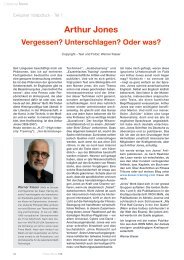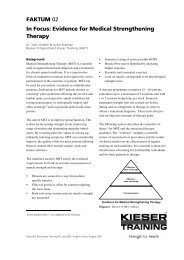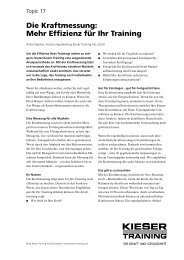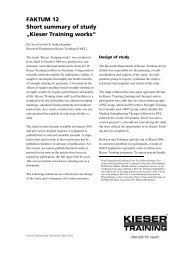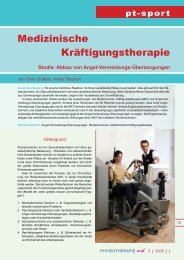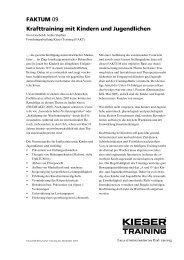Study: Strength training for chronic back pain - Kieser Training
Study: Strength training for chronic back pain - Kieser Training
Study: Strength training for chronic back pain - Kieser Training
You also want an ePaper? Increase the reach of your titles
YUMPU automatically turns print PDFs into web optimized ePapers that Google loves.
2<br />
OrIGINALIA STrENGTh TrAINING fOr ChrONIC BACk PAIN<br />
INTrODuCTION<br />
PROBLEM AND AIM<br />
This article looks at the effect of a 6-month programme of independent<br />
machine-based strength <strong>training</strong> on individuals with <strong>back</strong><br />
<strong>pain</strong> in the early stage of chronification as compared with a control<br />
group on a waiting list. It is assumed that intervention reduces the<br />
level of <strong>pain</strong> experienced and its effects.<br />
Episodes of mild or moderate <strong>pain</strong> in the early stage of chronification<br />
often ease without treatment. Existing data shows that this<br />
can be up to 20% within 6 months [12]. To ensure that this factor is<br />
reflected in the evaluation of an intervention, the net effect is calculated<br />
(the difference between the effect of the intervention and the<br />
changes in control group).<br />
The bio-psychosocial explanatory model <strong>for</strong> <strong>back</strong> <strong>pain</strong> has<br />
gained general acceptance, i.e. the potential triggers or risk factors<br />
are not only biological in origin but psychological and social factors<br />
also play a role. Pfingsten has stated: “In most cases of prolonged<br />
<strong>back</strong> <strong>pain</strong>, although the origin could be traced <strong>back</strong> to an existing<br />
physical process (e.g. muscular dysfunction), the physical origin<br />
quickly lost its significance and was replaced by psychological factors<br />
in which cognitive beliefs and their associated effect on behaviour<br />
become paramount” [14, p. 84 1 ]. In the longer term, the anxiety<br />
surrounding physical exertion and the resultant physical inactivity<br />
cause a deconditioning of the muscles. Following an analysis of<br />
the main functional muscles in the trunk and neck, Denner found<br />
that patients with <strong>back</strong> <strong>pain</strong> had poor levels of strength and per<strong>for</strong>mance<br />
[2]. The current treatment <strong>for</strong> patients with <strong>chronic</strong> <strong>back</strong><br />
<strong>pain</strong> is designed to restore function, reduce the effects of <strong>pain</strong> and<br />
the anxiety associated with certain movements, control <strong>pain</strong> and<br />
overcome physical inactivity.<br />
Physical <strong>training</strong> offers the potential to achieve the above treatment<br />
aims. Most randomised, controlled studies in this field have<br />
been carried out on patients with <strong>chronic</strong> lumbar<br />
<strong>pain</strong>. Reviews show that physical <strong>training</strong> is<br />
at least as beneficial in terms of effectiveness as<br />
conservative treatments [9]. The studies that have<br />
produced superior results primarily included exercises<br />
to strengthen muscles and stabilise the<br />
trunk [9].<br />
mEThODOLOGy<br />
The data was generated during a multi-centre study<br />
between April and October 2009 with a group<br />
of volunteers displaying differing states of health.<br />
The study was conducted in the strength-<strong>training</strong><br />
facilities of an international provider of strength<br />
<strong>training</strong>.<br />
Design and Procedure<br />
Participants were recruited via the media from<br />
members of the adult German population. The intervention<br />
lasted 6 months. All participants were<br />
provided with written in<strong>for</strong>mation on the aims<br />
of the study and consented in writing to their<br />
participation. In order to achieve greater representation,<br />
the study was conducted at multiple<br />
1 translated by author<br />
centres. Diagram 1 shows the procedure adopted starting with the<br />
procedure to draw lots in order to select participants through to the<br />
random sampling procedure used <strong>for</strong> the sub-study “Chronic Back<br />
Pain”, which is the subject of this article.<br />
Inclusion criteria:<br />
• Back <strong>pain</strong> <strong>for</strong> more than 12 weeks or a minimum of two<br />
recurring episodes of <strong>pain</strong> each year <strong>for</strong> at least 2 years<br />
• Chronification stage 1 or 2 [7]<br />
• Able to do independent strength <strong>training</strong> following an<br />
assessment by the doctor<br />
Exclusion criteria:<br />
• Known osteoporosis<br />
• Non-stabilised cardio-vascular disorder, acute injury or<br />
inflammation affecting the musculoskeletal system, motor<br />
disorder, state post surgery<br />
• Current or previous customer of the provider<br />
Data was collected at the start of the study, after 3 months and after 6<br />
months. In order to ensure a standard methodology <strong>for</strong> both <strong>training</strong><br />
and data collection, all trainers and doctors involved in the study were<br />
given identical <strong>training</strong>. All facilities had identical <strong>training</strong> equipment<br />
and the <strong>training</strong> programmes and load norms used were the subject<br />
of binding rules.<br />
Participants<br />
Table 1 describes the sample and the characteristics of the sample<br />
group at the start of the intervention (no significant differences). Most<br />
of the participants had <strong>back</strong> <strong>pain</strong> in Stage 1 of chronification and moderate<br />
levels of <strong>pain</strong>. Individual diagnoses were not divulged to the<br />
study, which was only in<strong>for</strong>med of the symptoms as shown in Table<br />
1. Almost all participants reported lumbar <strong>pain</strong> in the last month.<br />
Diagram 1: Flow Chart <strong>for</strong> randomisation and sampling procedure





